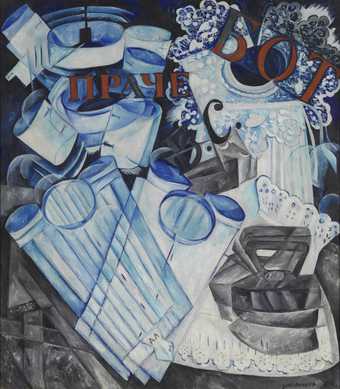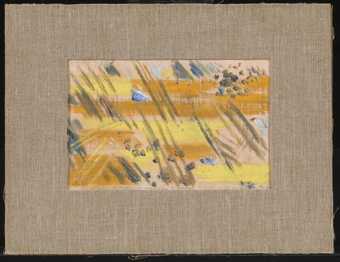
Ideas Depot
Free- Artist
- Natalia Goncharova 1881–1962
- Original title
- Trois jeunes filles
- Medium
- Oil paint on canvas
- Dimensions
- Support: 1019 × 683 mm
frame: 1093 × 758 × 56 mm - Collection
- Tate
- Acquisition
- Presented by Eugène Mollo and the artist 1953
- Reference
- N06193
Display caption
The apparent abstraction of this composition derives from the radically restructured forms of the three women identified in the title. Many years after its completion, the artist described it as: ‘Three half-length female figures, the play of sunlight and reflections of a sandy path (yellowish orange) and orange red etc.’ The fragmented forms that Goncharova favoured in earlier works were here resolved in a more stable synthesis that reflect her contribution to developments in post-First World War Paris.
Gallery label, November 2007
Does this text contain inaccurate information or language that you feel we should improve or change? We would like to hear from you.
Catalogue entry
Nathalie Gontcharova 1881-1962
N06193 Trois Jeunes Filles (Three Young Women) 1920
Inscribed 'N. Gontcharova. [cyrillic letters] 910.' t.l. and 'N. Gontcharova.' b.l.; and on back of canvas 'N. Gontcharova. [cyrillic letters] | .N GONTCHAROVA. | "Automne"' and in cyrillic 'MOSKVA. | Trekhprudniy pereulok | ... | dom 2 | 7 | Goncharova'
Oil on canvas, 40 1/8 x 26 7/8 (102 x 68.5)
Presented by Eugene Mollo and the artist 1953
Exh:
Goncharova-Larinov Exhibition, Kingore Gallery, New York, January 1922 (26) as 'Three Young Women' 1920
Lit:
Mary Chamot, 'The Early Work of Goncharova and Larionov' in Burlington Magazine, XCVII, 1955, p.174, repr. p.172; Mary Chamot, Gontcharova
(Paris 1972), p.102
Repr:
Apollo, CXVI, 1957, p.77
This picture is dated 1910 alongside the signature written in cyrillic letters and is entitled on the back 'Autumn'. It is said by the artist to have been painted in August 1910, and to have been included in her joint exhibition with Larionov at the Galerie Paul Guillaume in Paris in June 1914 (54) as 'In the Park (1910)' and before that at the Society of Free Aesthetic in Moscow in 1911 as 'Autumnal Park'. 'Three half-length female figures, the play of sunlight and reflections of a sandy path (yellowish orange) and orange red etc. In this combination the moving forms of light seen between solid shapes are considered (as this is painting on canvas) as immovable, like the forms of leaves (material forms), the forms of tree trunks, the stylised forms of reflected light - that is one of the forms of rayonisin where light is considered as a material basis and where, in painting, it corresponds to material colour and hence the method of applying the paint to the canvas side by side with the other method of smearing the paint. A purely pictorial play results from this, and the effect produced by this juxtaposition is taken into account. The effect is regarded as a new aesthetic experience, a new aesthetic emotion' (letter of 18 February 1954).
However it is now generally agreed that Gontcharova must have been mistaken and that the date 1910 cannot be correct. There is no confirmatory evidence that it was included in either of the early exhibitions she mentions and the fact that it has no label of Der Sturm on the back, unlike N06194, would seem to imply that it was not among the pictures shown in Paris in 1914. None of the paintings reproduced by Eganbury in his book on Gontcharova and Larionov published in 1913 is at all close to it in style and it cannot be positively identified in his list of her works. Unlike the signature at the bottom, which was written into the yellow paint while it was still wet, the signature in cyrillic and date 1910 at the top were added when the paint was dry, perhaps years afterwards. The Moscow address on the back (the same address as that on the back of Larionov's 'Nocturne' N06192) also appears to have been added subsequently, and is possibly in Larionov 's handwriting.
Although described by the artist as a kind of Rayonism, it actually seems to have more connection with late synthetic Cubism, such as the work of Picasso of about 1915-16. Gontcharova's stylistically most closely related work is a large painting of 'Bathers' which was dated 1912-13 by Camilla Gray in the Arts Council's Larionov and Gontcharova exhibition of 1961 (cat. no.114) and 1916 by Mary Chamot on page 95 of her monograph, but which Mary Chamot now believes may have been made several years later because of its similarity to a colour lithograph made by Gontcharova about 1922 for an album of prints by Italian and Russian artists, Neue europäische Graphik 1921-23, published by the Bauhaus, Weimar. She points out that it seems unlikely that Gontcharova would have made a print in a much earlier style for such an important project.
A further clue to the date of N06193 is provided by a torn label formerly stuck in the bottom left-hand corner (now removed, but visible in photographs taken at the time of its acquisition), with a number 20 or 26. This would appear to identify it as no.26 in the Goncharova-Larionov Exhibition at the Kingore Gallery, New York, in 1922 listed as 'Three Young Women. Paris, 1920'. In fact this title corresponds to one, 'Trois Jeunes Filles', which appears on a label on the stretcher.
A crayon drawing for this picture is reproduced by Chamot, op. cit., p.94. It is slightly less abstract and the forms have more modelling.
Published in:
Ronald Alley, Catalogue of the Tate Gallery's Collection of Modern Art other than Works by British Artists, Tate Gallery and Sotheby Parke-Bernet, London 1981, pp.297-9, reproduced p.297
Explore
- abstraction(8,615)
-
- from recognisable sources(3,634)
-
- figure(2,270)
- non-representational(6,161)
-
- colour(2,481)
- formal qualities(12,454)
-
- cubist space(86)
- fragmentation(233)
- group(4,227)















